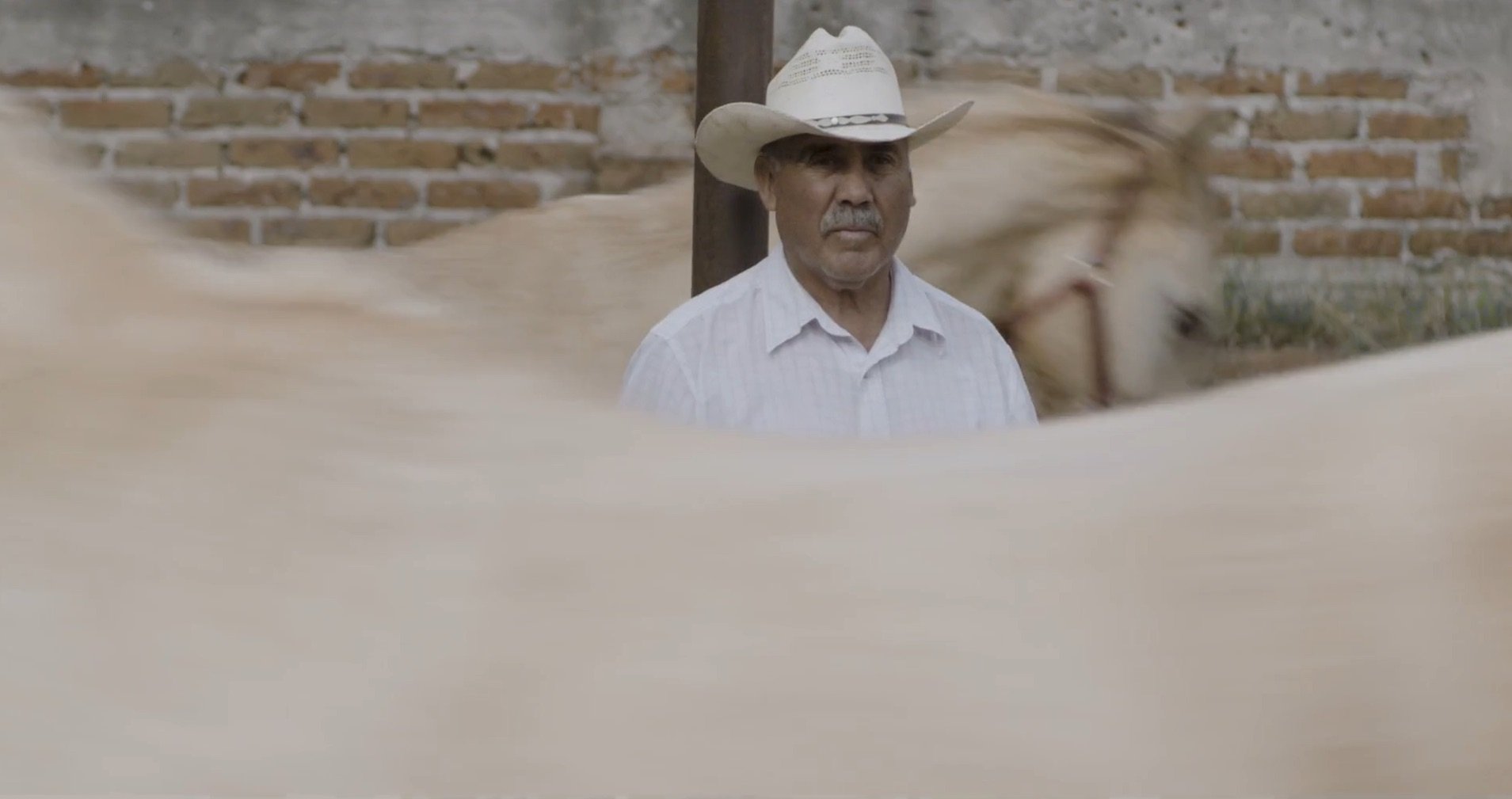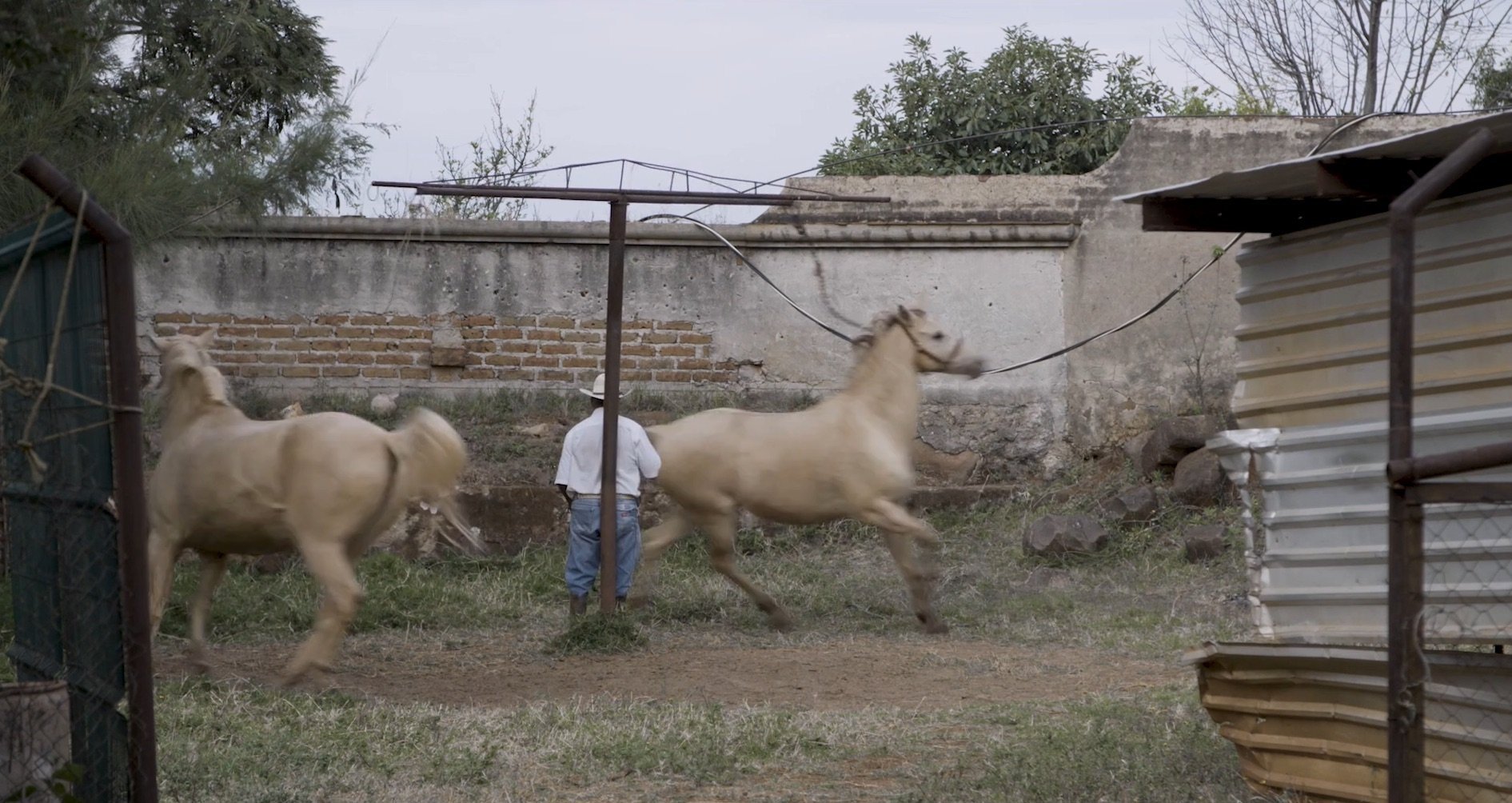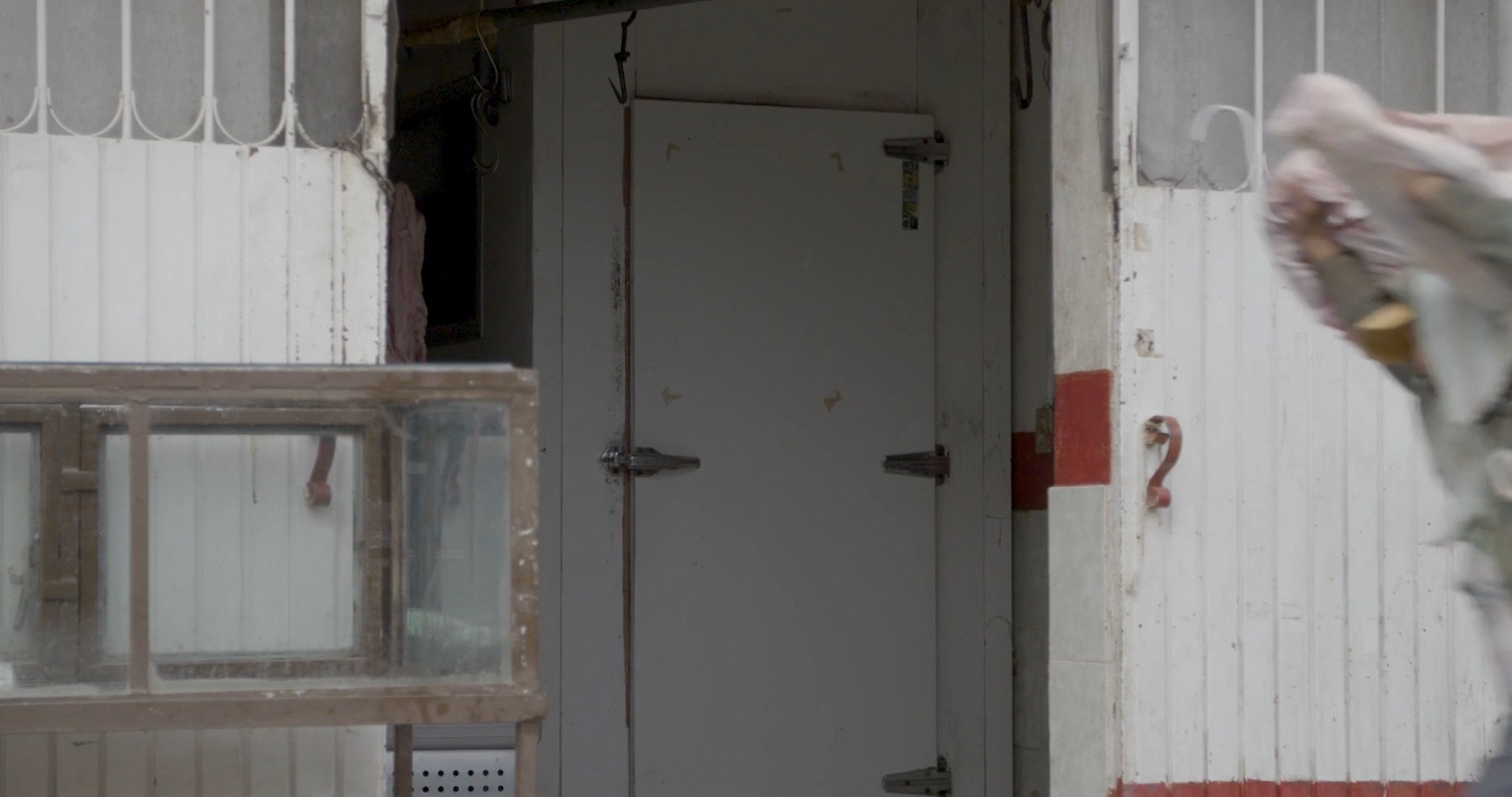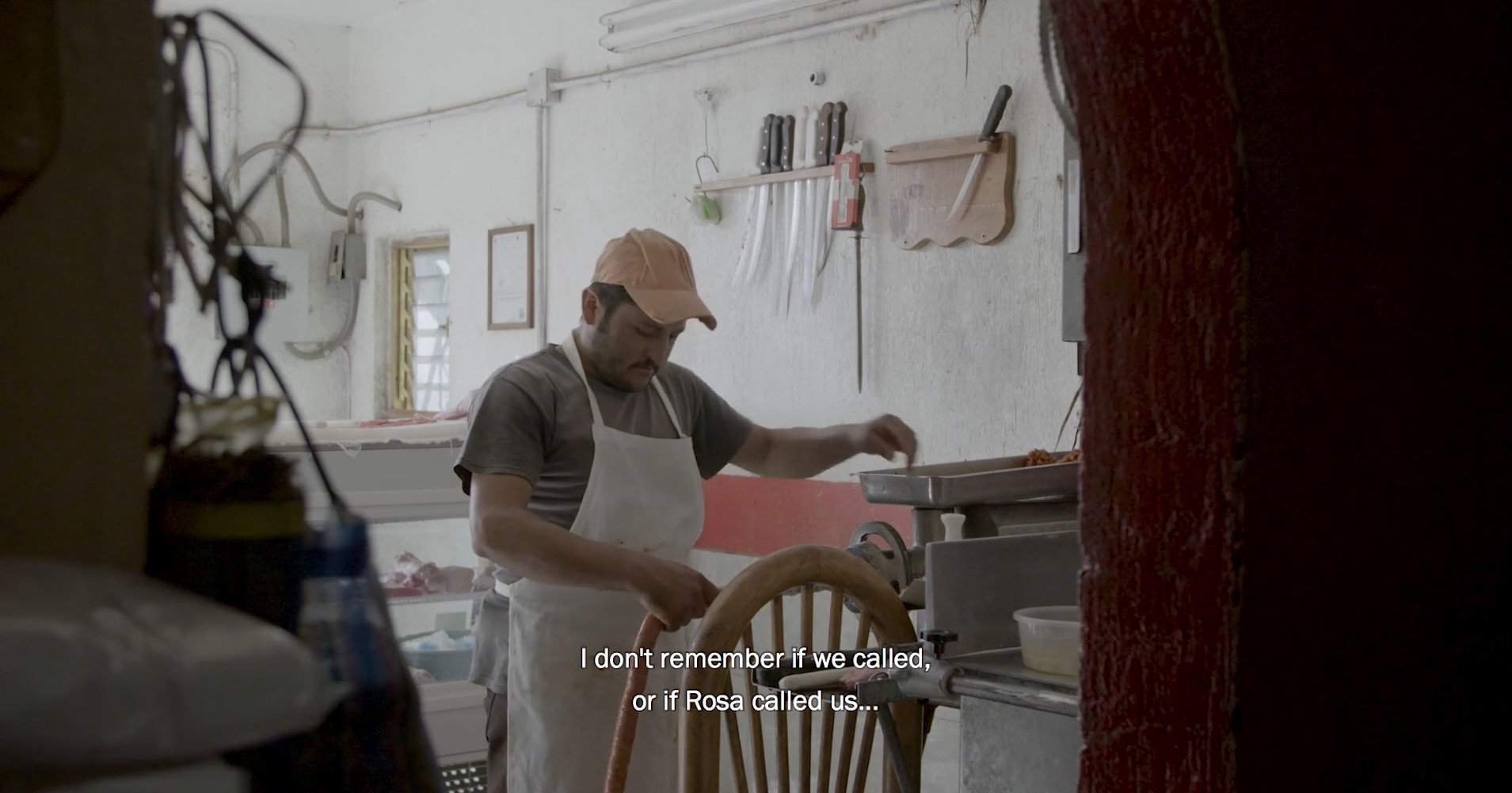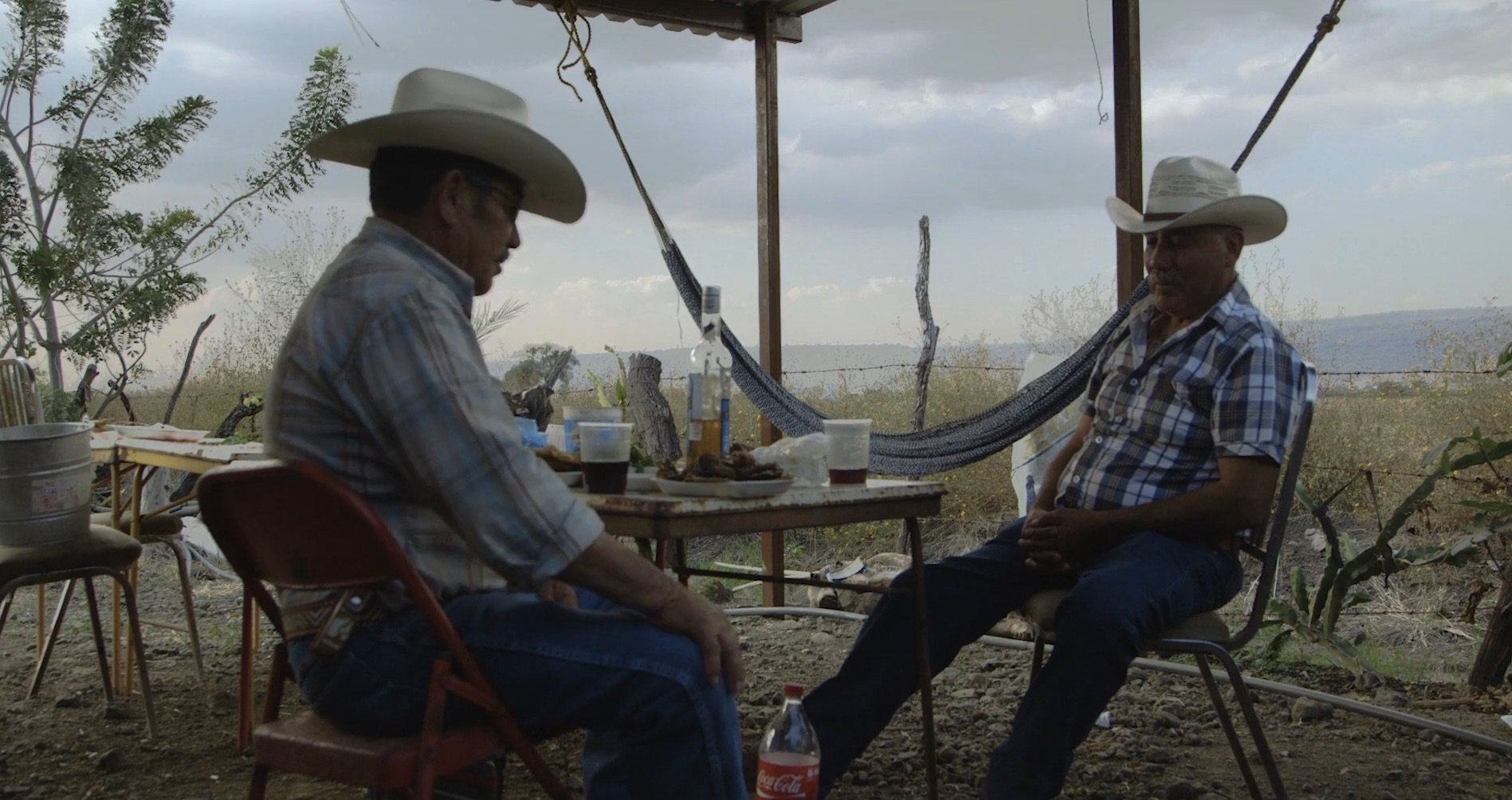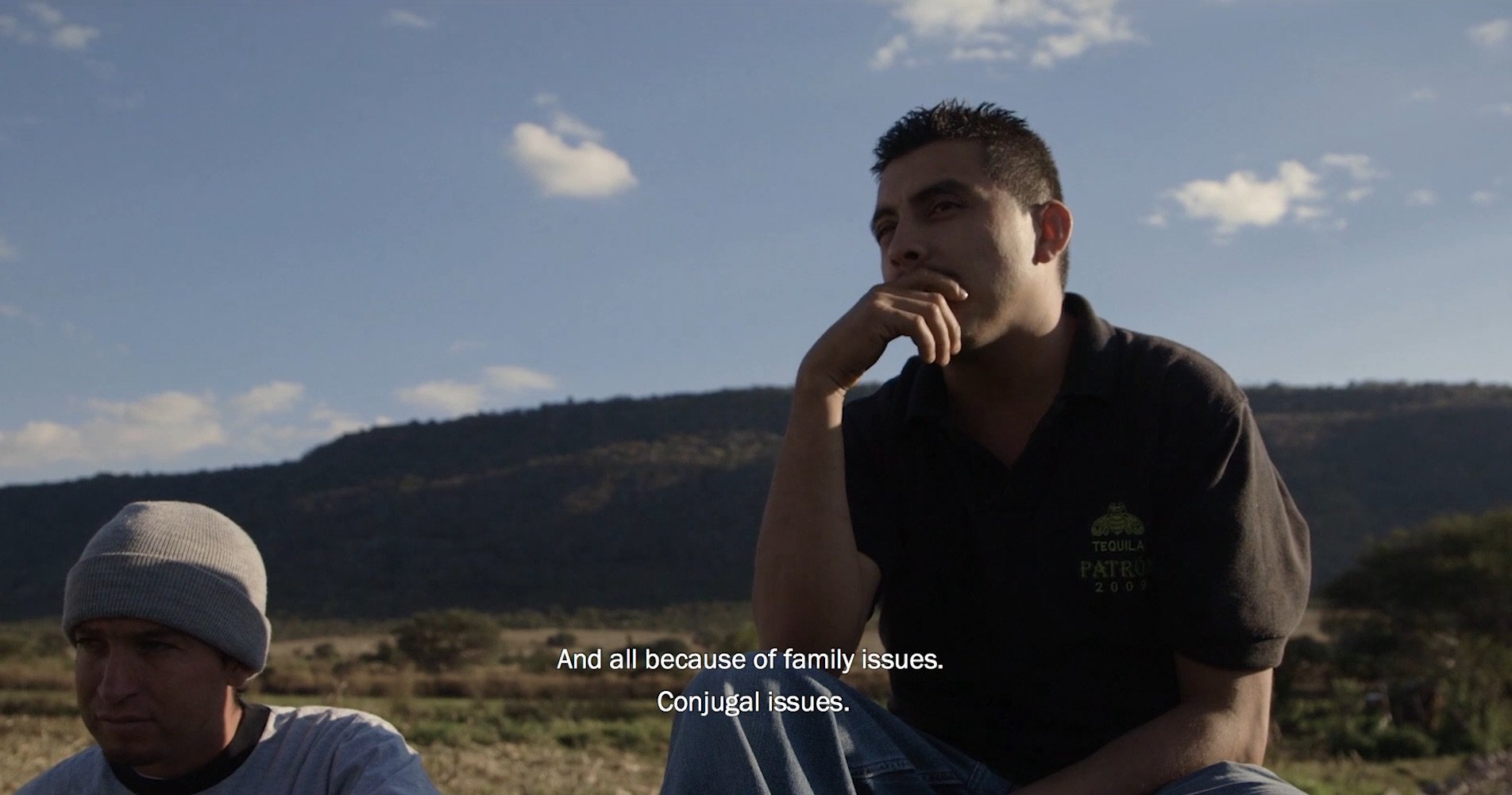OF WOUND AND RESISTANCE ◯ Presenting The Solitude of Memory (2014) and Caballerango (2018) by Juan Pablo González
Still from Caballerango – within the horsewalker – (2018) © Juan Pablo González
Athens Design Forum presents the early documentaries of Mexican Director Juan Pablo González: The Solitude of Memory (2014) and Caballerango (2018). Juan Pablo González returns to his place of birth within the agricultural communities of Jalisco, Mexico, forming a gesture of re-recognition. Quotidian landscapes – barbershops, butcher shops, nail salons – alongside dense agricultural plots, become the sites where a community of sowers come to mourn the death by suicide of Nando, a horse wrangler’s son. Bereft of their land, they form a wound of resistance that grows and crusts over. The Solitude of Memory, a precursor to the feature documentary film, Caballerango, centers on the protagonist José, Nando’s father, and the last words he said to his son. With the director’s voice an integral element that softly brings to surface elements of a community in the shadows – just as in the metaphorical image of a sower who tills in hopes of a fertile overturn – Juan Pablo González emancipates his protagonists, allowing stillness to be as provocative as a vision of elongated movement. Through themes of religion, political activism, labor, and camaraderie, González’s films sensitively portray the agricultural communities of Jalisco, grounding their narratives in the landscape as a silent yet penetrative witness.
☆ Join us for a double screening, of The Solitude of Memory and Caballerango, co-hosted with The Cervantes Institute, Athens.
February 13, 2025 – 6:30 pm \ Skoufa 31, Athina 106 73
The screening will be in Spanish with English subtitles. A short Q&A will follow with Athens Design Forum founder, Katerina Papanikolopoulos.
In an exclusive interview with Juan Pablo González, Athens Design Forum delves into the representation of laboring classes and the use of spatial elements in shaping community identity, offering a unique analysis of the films’ achronic pulse and structural foundations.
Still from Caballerango – within the horsewalker – (2018) © Juan Pablo González
01 ON THE IMPENETRABLE IMAGE OF PLACE
Athens Design Forum, Katerina Papanikolopoulos: How does the juxtaposition of different scenes, and their evolution onward, affect the viewer’s understanding of the agricultural context and spatial surroundings? How does suicide become represented as an absence? We begin with the sight of the white horse and end with a slow pan as the animal gazes at us.
Still from Caballerango’s closing sequence (2018) © Juan Pablo González
Juan Pablo González: At the time I made this film, I was very moved by the spectral qualities that certain cinematic images could have. They reminded me of home – of the way I grew up, always reminded of a world beyond this one. Certain images of this film evoke that to me. So, for example, it’s not precisely the horses that provoke this evocation in me but a particular image of the horses, or a particular image of a landscape. To me, images evoke a timeless presence which is something quite beautiful. They allow us to enter a dimension that is impenetrable in real life. In general, both Caballerango and The Solitude of Memory present a particular rhythm of how I experience life when I am in Atotonilco and Milpillas. I don’t know if that is everyone’s experience of this place, but it is mine. That is the reason why I chose to film in the way I did, and it greatly influenced the editing. We thought of the editing as a process of unfolding. This is a community that had never been filmed for the cinema so it was important for me that the place revealed itself to people as the film – especially Caballerango – advanced. As you watch the film, you get to know new people, and you get to experience quotidian aspects of the community that have nothing to do with what the film is recounting [Such as Jose’s preparation of lunch, the butcher shop and nail salon where we interview the relatives of the family]. However, personally, I think the film couldn’t exist without them.
Within Caballerango, ‘place’ was always inextricable from the world that the film was trying to create. This film is, in many ways, about a certain modernization of rural Mexico. So, it was impossible for me not to think about labor and land – different types of labor related to land and others related to new economic forms developing in a place like Atotonilco. A land reform in the 1930s gave much of the farmland back to farmers and peasants, following a particular political and policy history in Mexico. So, still in the 1990s, most small farmers in Mexico owned their piece of land through ejidos (a sort of farming co-op). That was reversed in the 1990s and changed everything for farmers since the market ruled their lands and crops.
Still from Caballerango – butcher’s shop details within entryway (2018) © Juan Pablo González
Still from Caballerango – butcher’s shop details interior (2018) © Juan Pablo González
In this whole film, and my work in this region, labor plays a crucial role. For me, the butcher shop is a place that traces past and present labor practices in Milpillas. This shop has been here for almost a century and its structure bares the town's transformation. This butcher shop is a sort of landmark ‘territory’ for the town. Before the counter-land reform of 1994, this was the limit or the frontier between the town and the land that was used for cultivation. After the land was privatized, the town expanded way beyond this shop.
Still from Caballerango – nail salon interior perspective (2018) © Juan Pablo González
The nail salon is probably more related to character and narrative — it is Vero's salon, that is where she spends most of her time, and it was important to film her here doing what she does every day. However, as you might imagine this is a relatively new business in the region. Vero has been doing it for about fifteen years now. Before then, Vero would work the land with her father. But, since her father's land has been so diminished and it is not a source of enough income or food for the family anymore, Vero had to find a new job. Also, the idea of a "business" outside of fruterías, misceláneas, tortillerías and carnicerías — all shops related to food consumption — is relatively new in the village, as it didn't exist thirty years ago.
Still from Caballerango – interior fumigation sequence (2018) © Juan Pablo González
People have offered many interpretations of the fumigation scene. But to me, this scene is not symbolic and there is nothing really to interpret from it. It's just another depiction of this town's daily life. But, also perhaps, a glimpse on the role of the state or of government proper in this community. These are fumigation campaigns carried out by the municipal government during rain season to stop the spread of dengue fever.
Still from Solitude of Memory (2014) © Juan Pablo González
02 ON THE ACT OF PRESENCE & THE PRESUMPTIVE TRUTH
ADF: What role does your observation and questioning play in the storytelling process of the film?
JBG: Throughout my work, I’ve approached filmmaking as an act of presence. Both the presence of what is in front of the camera (human presence, nature) and myself behind the camera. So, I cannot make a film without incorporating people’s interactions with their environment. What this has meant for me is that I have designed a manner of shooting that tries to allow people to move freely in and out of the frame and not be interrupted by our presence. When I’m not the one filming, I avoid staying behind the camera to ensure my presence in the space feels of the same weight as anyone else’s. Most of what we do in these shoots is be with people. We shoot for no more than three hours daily, sometimes even less. The rest of the time we are there talking and eating with people, helping them with their chores, etc. Most of the people I shoot with I’ve known since childhood, so for me, that is just the natural way of inhabiting these spaces.
Still from Caballerango – taco lunch sequence (2018) © Juan Pablo González
The inclusion of my voice and, therefore, my presence in the film, was always an element that I knew would be there. I studied documentary film in the US and, at the time, there was a presumption of truth in documentaries that I always deemed questionable. Then, I made Solitude of Memory and realized how much construction goes into a non-fiction film (probably as much as in fiction) and realized that the presumption of truth was not only questionable but dangerous – it could serve so clearly as an instrument of deception and manipulation. So, my way of countering that notion is by always establishing that there is someone behind the camera framing everything you are experiencing. And, in the case of my conversations with the participants of both films, what my voice is doing is triggering these retellings. And, of course, people are choosing to speak to me when they respond, but ultimately you are watching this through my point of view.
Still from Caballerango – in dialogue with young agricultural workers (2018) © Juan Pablo González
03 ON COLLECTIVE GRIEF
ADF: How is the theme of suicide represented, and what does it reveal about personal and collective trauma within the community?
JPG: To me, this film is not so much about suicide but about collective grief - how a community mourns its youth, a youth that, at that point, felt so disillusioned that this collective tragedy took place. However, the larger project of continuing to make films in this village also reflects the community's resilience, because through support groups they have managed to stop suicides almost entirely in less than ten years.
04 ON THE SEASONS OF EXISTENCE
ADF: What insights does the film provide about the relationship between land use and community identity?
JPG: As my interest in poetry grew from a young age, I would find it quite strange to read such beautiful texts about the spring season. In my region, spring is always terribly hot and dry. This is because, in this part of Mexico, we only experience two seasons: the wet season and the dry season. For people, the dry season is a preparation period. Typically, in late winter and throughout the spring, people prepare the land for the cultivation of milpa (a milpa gives families corn, calabaza, chile, and beans and it typically feeds families for at least six months, if not more) and once the first rains comes in the late spring (this has shifted recently because of climate change), they begin sowing. People usually sow in stages so that they have food through the summer, fall, and winter. Next spring, the process begins again. One can only imagine how farming here is inextricable from general existence.
Still from Caballerango – agricultural cultivation (2018) © Juan Pablo González
05 ON MALE EXPRESSIVITY IN AGRICULTURAL COMMUNITIES
ADF: How does the quote about the value of corn illustrate the exploitation of labor in agricultural systems? <Why is the corn so cheap? ....It’s only cheap when they buy it from us. Then they resell it at higher prices. But when we are harvesting, they drop the prices. Then the rich get it in their warehouses and raise the prices again. Only then is it worth something. Not when it’s ours.> (25:27)
JPG: Caballerango is a film about grief but it is also a film about male expressivity – José’s presence in the film shows a kind of vulnerability that we rarely see in films about men from Jalisco ranching communities. José’s family history exemplifies what has happened to most peasant families in Mexico throughout the 20th century and the beginning of the 21st. José’s family received farming land during the 1930s land reform and then his land was privatized during the 1990s. This has meant that little by little he and his family have lost their land – in only thirty years it’s almost entirely gone. Like so many other farmers in Mexico, José and his family have stopped growing milpa and have began growing lime for US consumption — others are now growing agave, avocado, etc. So, on the one hand, his possibilities of making a living through farming have greatly diminished while at the same time, he has stopped farming for self-subsistence. Outside of the particularities of how corn commerce works in Mexico, a problem that continues to affect small farmers is the high costs of transporting or exporting the goods they make. So, since they cannot transport those goods and take them to wholesalers in the city or export them to the US, these businesses are dominated by food distribution companies (empacadoras) and foreign corporations. This is, of course, by design – leading to farmers not being able to sustain themselves and finally having to sell their land. More and more, these lands fall into the hands of global conglomerates dedicated to large-scale monoculture farming. This has been a devastating (both socially and environmentally) trend for most rural communities in Mexico.
Still from Caballerango – interior truck with dialogue on agricultural politics (2018) © Juan Pablo González
06 ON THE LABORING CLASS
ADF: How does the film relate to agriculture as a political act or movement for the laboring class? <I wouldn’t mind bringing back Pancho Villa, and starting another revolution. Who’d be crying then?> (25:38)
JGP: There is an assumption in Mexico – especially in urban areas and in conservative economic and political circles – that rural communities aren’t politicized. Besides being a racist and classist assumption, it is also a very convenient one. Because, among other things, the inhabitants of these regions become easy targets of criminalization. The discourse is that if there is any unrest in rural communities it is not because people are fighting for their rights or organizing to demand better living conditions, it is because they are criminals and unruly in nature. This discourse greatly serves the narco-war narrative, to give just one example, and has become another instrument for dispossessing people of their land.
Still from Caballerango (2018) © Juan Pablo González
JUAN PABLO GONZÁLEZ
A 2024 Guggenheim and MacDowell Fellow, Juan Pablo González is a filmmaker whose work spans fiction and nonfiction. His films are largely based in his hometown of Atotonilco el Alto. Dos Estaciones (2022), Juan Pablo’s feature length debut, received the Special Jury Award for Acting at the Sundance Film Festival and screened at New Directors/New Films (MoMA / Lincoln Center), San Sebastián International Film Festival and Morelia International Film Festival (FICM) where Teresa Sánchez received the Best Acting Award. His mid-length debut, Caballerango premiered at IDFA in 2018 and played at Ambulante, FICUNAM, BAM Cinema Fest, True/False, among many others. In 2020 Juan Pablo had his first solo exhibition titled What I Do To Remember at the Visual Arts Center (VAC) at UT Austin’s Department of Art and Art history. Juan Pablo’s debut short film The Solitude of Memory (2014) had its World Premiere at the Morelia International Film Festival, its International Premiere at IDFA, and received the Grand Jury Prize for Documentary Short at Slamdance in 2015. His follow-up, the scripted La espera (2016), premiered at SXSW and won the Grand Jury Prize at the New Orleans Film Festival. In 2017, Juan Pablo’s short piece, Las Nubes, premiered at the Festival de Nuevo Cine Latinoamericano en la Habana, then went on to play at Rotterdam (IFFR), True/False, Lincoln Center of New York, and received the Grand Jury Prize at Festival dei Popoli. Juan Pablo was awarded the 2022 True Vision Award at the True/False Film Festival that included a program focused on his documentary and fiction work at that year ‘s festival. He was named one of Filmmaker Magazine’s “25 New Faces of Independent Film” in 2015, has been a fellow of the Fund for Culture and Arts (FONCA) in Mexico and was awarded the 2021 Vilcek Prize for Creative Promise. In 2023 Juan Pablo’s work had a spotlight program at The Center for Fine Arts (BOZAR) in Brussels, Belgium. Currently, Juan Pablo’s entire body of work is being featured on the Criterion Channel.
FILM SYNOPSIS
The Solitude of Memory (2014): Through a dialogue between its formal elements and its characters, The Solitude of Memory unfolds as a profound meditation on memory and grief as a father repeatedly recalls the last words that he spoke to his son before the young man took his own life.
Caballerango (2018): Death haunts a close-knit Mexican community in this evocatively spare, slow-burn documentary spellbinder. With a remarkably unobtrusive camera, director Juan Pablo González chronicles the everyday rituals and rhythms of life in a small, struggling rural town in the state of Jalisco where daily conversation seemingly turns again and again to one topic: the recent suicide of a young caballerango (horse wrangler) whose death, we soon learn, is only the latest in a rash of suicides that have plagued the village. Finding stirring poignancy in seemingly quotidian moments, Caballerango is a transcendentally sad and beautiful reflection on vanishing traditions and disappearing lives. via the Criterion Channel
